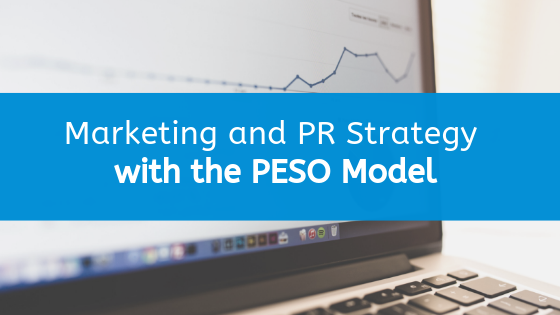Marketing and PR Strategy with the PESO Model
I’ve been hearing a lot about needing strategy from potential clients lately. They are running a business or organization with many moving parts, and just getting promotions out the door is an accomplishment sometimes. What they crave is the structure of strategy, the peace of mind that all the Ts are crossed, Is are dotted and nothing is falling to the wayside. That is one of the reasons they work with us, because we bring that structure. Our “secret sauce” is the PESO model.

When we build a Marketing and PR strategy for our clients, we use the PESO model. This is a model for strategy developed by Gini Dietrich, author of Spin Sucks. She created it to empower PR professionals to be more and do more than the typical idea of public relations. It is also a fantastic approach to building strategy. The acronym stands for Paid, Earned, Shared and Owned Media. When all of these tactics are coordinated together, it provides a solid structure for marketing and public relations strategy.
P is for Paid
Paid media is often the first thing people think of when they want to promote an idea or service. And it definitely has a place in a robust strategic plan. But it doesn’t have to break the bank, and it really needs the support of its three companions.
Every year, we help promote the annual NY Ice Wine & Culinary Festival that takes place at Casa Larga Vineyards in February. We place ads with local radio stations to get the word out, and we reach people with Facebook ads. But people need to get information on the festival from the website (owned), and we talk about it on all social media channels for about four months leading up to the event (shared). And we also do a lot of PR activities to bring attention to it (earned).
E is for Earned
Earned media is another way of saying public relations. With PR efforts, the end results are placements – articles, interviews, blogs – that are not paid advertisements. Instead, they are third party endorsements by the news anchors, journalists, media personalities and trade publications that people know and trust. This publicity helps promote your organization and tell your story through different voices and angles, including ways you may not be able to talk about yourself.
We work with destinations across Upstate New York whose websites share factual details about their assets and attractions. While these descriptions are informative, an article or blog post can dig deep into first-hand encounters and emotions. For example, Mary Chong of Calculated Traveller shared her personal experience horseback riding that paints a vivid picture beyond what one might read in a brief website description.
S is for Shared
Shared platforms – social media – were long debated. Who “owns” and takes responsibility for a brand’s social channels? I love that this model essentially ends the tug-of-war between marketing, sales and PR. Social is its own thing – a channel and a way of reaching people in its own right. Managing social media requires a unique skillset and knowledge of the digital landscape.
Another reason I love that this is called Shared Media and doesn’t fall under owned media, is because these social platforms are separate entities. Your email provider cannot take away your customers’ emails. But a social media platform has the final say in how you reach your customers on their platform. This is a concept covered really well in the book Killing Marketing by Joe Pulizzi and Robert Rose.
O is for Owned
Owned Media are the places you can share your messages that you have full control over. It’s the channels that you own – your website, blog, email newsletters, mailing lists and phone numbers. It’s wherever you can reach your audience where you are in control of how and when and what the message is.
Each of these elements is an important pillar of marketing and PR strategy, but it’s only when they are planned in conjunction that you reap the full benefits of a strong strategy.
Author
Related Posts
Collaboration Drives Sustainable Tourism
Sustainable tourism has growing importance in the world of travel and tourism. As destinations grow in popularity, they need to collaborate closely with residents, local…
Marketing for Group Travel: Building Solid Relationships with Tour Operators
Group travel is a significant segment of the tourism market, and if you want to see those buses pulling up to the curb and filling…
